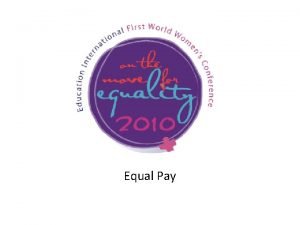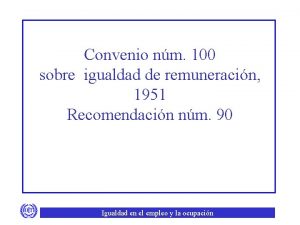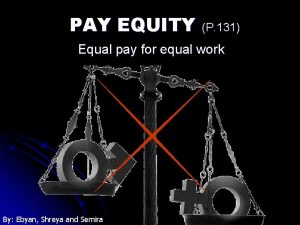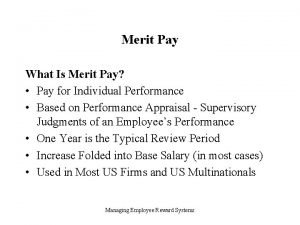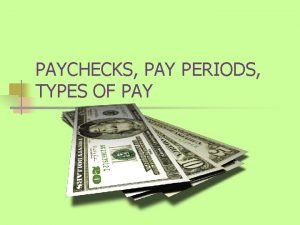Equal Pay Equal Remuneration Convention 1951 No 100













- Slides: 13

Equal Pay

Equal Remuneration Convention, 1951 (No. 100) ARTICLE 2 1. Each Member shall, by means appropriate to the methods in operation for determining rates of remuneration, promote and, in so far as is consistent with such methods, ensure the application to all workers of the principle of equal remuneration for men and women workers for work of equal value.


Pay equity means: - equal pay for the same work where identical jobs are compared - equal pay for work of comparable worth/equal value for jobs that are not identical - addressing the wage gap between female and male dominated jobs - taking structural categories such as race, ethnicity, disability, etc. into consideration - strategies for political awareness and the implementation of pay equity programmes.

What is Pay equity? • Pay equity aims to eliminate gender discrimination in the setting of wages. Originally pay equity simply referred to equal pay for equal work. However many jobs, while not identical, still require equal skills and can be said to be of equal value. So the definition was broadened to equal pay for work of comparable worth, even for jobs that are not exactly identical. • Teaching is a “feminised” profession, but generally speaking, the proportion of female teachers declines with the increasing age of students and higher earnings. • Gender bias means the way that value is assigned to work, reinforcing gender segregation in low paid and low status occupation.

The three gaps • The gap in education - Literacy rate and enrolment rate • The gap in economic activity - Rate of economic activity and estimated perceived income • The empowerment gap - % of women in technical positions, in management and government positions in parliament and in ministerial level positions


A short Norwegian history… • In 1911 the first woman met as a member of Parliament. • In 1913 women were granted the right to vote on the same terms as men. • In 1959 the Norwegian Parliament ended the practice of establishing lower wage scales for women than for men. • In 1978 the Gender Equality Act was passed. It states that men and women in the same enterprise shall have equal pay for the same work or work of equal value.

The Norwegian Equal Pay Commission • In its report on gender and pay, the Norwegian Equal Pay Commission gave five main reasons for the (hourly) pay differential between women and men, which is currently around 15%.

The Norwegian Equal Pay Commission • The wage-negotiation system maintains stable wage relationships, including those between women and men. • Wage disparities increase during parenthood. • Differences in age and educational attainment have little to do with the current wage gap. • Women and men have approximately equal pay in the same position in the same organisation. • The wage gap corresponds to gender segregation in the labour force.

One of seven proposals… • The authorities and the social partners should implement a pay increase for selected femaledominated occupations in the public sector. – Must co-operate and agree – Accept higher wage growth in public sector – Accept new relative pay differences – Allocation of fresh funding

What happened? • The trade union movement couldn’t agree on a strategy. • Public employers didn’t want extra funding. • The cross-sectoral gender segregated labour market was never really an issue. • We fought for our own members instead of fighting for women. • We lost the equal pay battle 2010.

Strategies and tools • Legislation – and follow-up mechanisms • Knowledge – statistics and research • Bargaining systems that don’t discriminate and that can facilitate change • Solidarity and co-operation • Political will and courage Achieving equal pay is achieving change – societal change
 Equal remuneration convention 1951
Equal remuneration convention 1951 100 100 100 100 100
100 100 100 100 100 1951 refugee convention
1951 refugee convention 1951 refugee convention
1951 refugee convention Convenio sobre igualdad de remuneración
Convenio sobre igualdad de remuneración Hublo inscription
Hublo inscription Rémunération globale pyramide
Rémunération globale pyramide Inclusive dispensation meaning
Inclusive dispensation meaning Advantages and disadvantages of remuneration
Advantages and disadvantages of remuneration Cours sur la rémunération en grh
Cours sur la rémunération en grh Cadbury report ppt
Cadbury report ppt Cned espace inscrit cours
Cned espace inscrit cours Labour remuneration
Labour remuneration Poplee remuneration
Poplee remuneration
